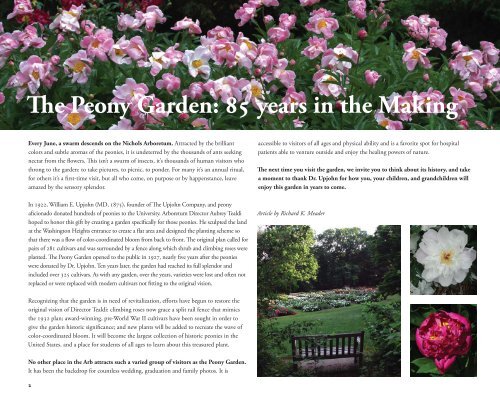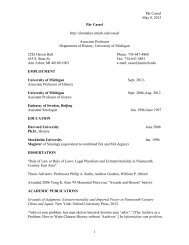Annual Report - College of Literature, Science, and the Arts ...
Annual Report - College of Literature, Science, and the Arts ...
Annual Report - College of Literature, Science, and the Arts ...
Create successful ePaper yourself
Turn your PDF publications into a flip-book with our unique Google optimized e-Paper software.
The Peony Garden: 85 years in <strong>the</strong> Making<br />
Every June, a swarm descends on <strong>the</strong> Nichols Arboretum. Attracted by <strong>the</strong> brilliant<br />
colors <strong>and</strong> subtle aromas <strong>of</strong> <strong>the</strong> peonies, it is undeterred by <strong>the</strong> thous<strong>and</strong>s <strong>of</strong> ants seeking<br />
nectar from <strong>the</strong> flowers. This isn’t a swarm <strong>of</strong> insects, it’s thous<strong>and</strong>s <strong>of</strong> human visitors who<br />
throng to <strong>the</strong> garden: to take pictures, to picnic, to ponder. For many it’s an annual ritual,<br />
for o<strong>the</strong>rs it’s a first-time visit, but all who come, on purpose or by happenstance, leave<br />
amazed by <strong>the</strong> sensory splendor.<br />
In 1922, William E. Upjohn (MD, 1875), founder <strong>of</strong> The Upjohn Company, <strong>and</strong> peony<br />
aficionado donated hundreds <strong>of</strong> peonies to <strong>the</strong> University. Arboretum Director Aubrey Tealdi<br />
hoped to honor this gift by creating a garden specifically for those peonies. He sculpted <strong>the</strong> l<strong>and</strong><br />
at <strong>the</strong> Washington Heights entrance to create a flat area <strong>and</strong> designed <strong>the</strong> planting scheme so<br />
that <strong>the</strong>re was a flow <strong>of</strong> color-coordinated bloom from back to front. The original plan called for<br />
pairs <strong>of</strong> 281 cultivars <strong>and</strong> was surrounded by a fence along which shrub <strong>and</strong> climbing roses were<br />
planted. The Peony Garden opened to <strong>the</strong> public in 1927, nearly five years after <strong>the</strong> peonies<br />
were donated by Dr. Upjohn. Ten years later, <strong>the</strong> garden had reached its full splendor <strong>and</strong><br />
included over 325 cultivars. As with any garden, over <strong>the</strong> years, varieties were lost <strong>and</strong> <strong>of</strong>ten not<br />
replaced or were replaced with modern cultivars not fitting to <strong>the</strong> original vision.<br />
Recognizing that <strong>the</strong> garden is in need <strong>of</strong> revitalization, efforts have begun to restore <strong>the</strong><br />
original vision <strong>of</strong> Director Tealdi: climbing roses now grace a split rail fence that mimics<br />
<strong>the</strong> 1932 plan; award-winning, pre-World War II cultivars have been sought in order to<br />
give <strong>the</strong> garden historic significance; <strong>and</strong> new plants will be added to recreate <strong>the</strong> wave <strong>of</strong><br />
color-coordinated bloom. It will become <strong>the</strong> largest collection <strong>of</strong> historic peonies in <strong>the</strong><br />
United States, <strong>and</strong> a place for students <strong>of</strong> all ages to learn about this treasured plant.<br />
No o<strong>the</strong>r place in <strong>the</strong> Arb attracts such a varied group <strong>of</strong> visitors as <strong>the</strong> Peony Garden.<br />
It has been <strong>the</strong> backdrop for countless wedding, graduation <strong>and</strong> family photos. It is<br />
2<br />
accessible to visitors <strong>of</strong> all ages <strong>and</strong> physical ability <strong>and</strong> is a favorite spot for hospital<br />
patients able to venture outside <strong>and</strong> enjoy <strong>the</strong> healing powers <strong>of</strong> nature.<br />
The next time you visit <strong>the</strong> garden, we invite you to think about its history, <strong>and</strong> take<br />
a moment to thank Dr. Upjohn for how you, your children, <strong>and</strong> gr<strong>and</strong>children will<br />
enjoy this garden in years to come.<br />
Article by Richard K. Meader

















